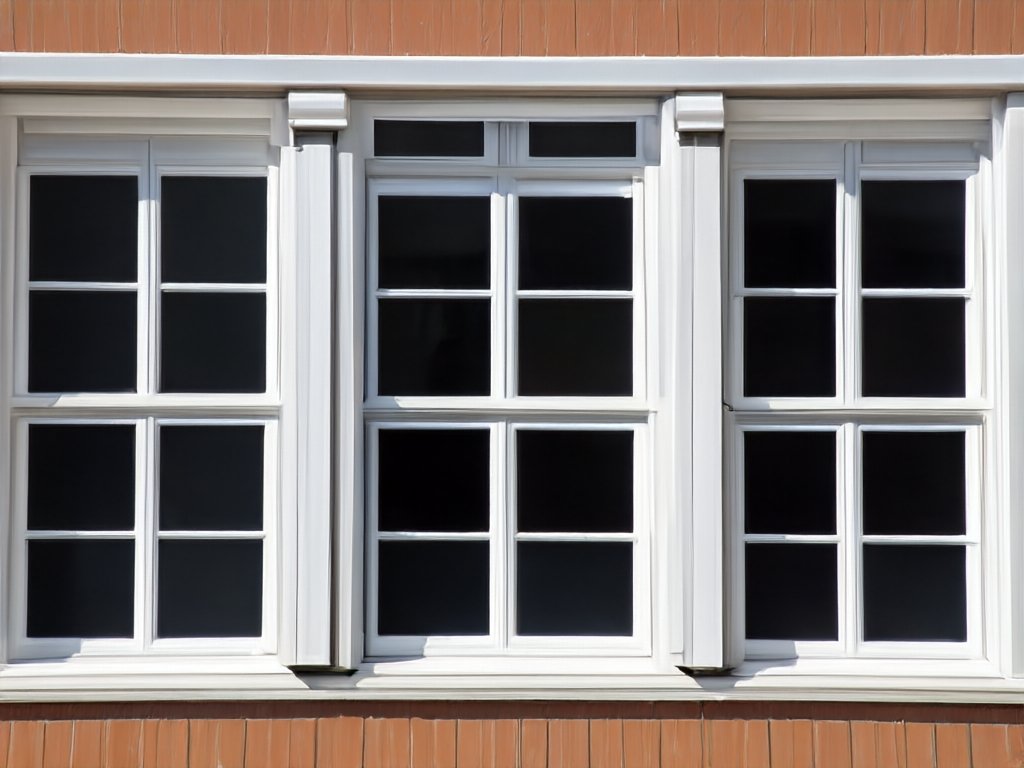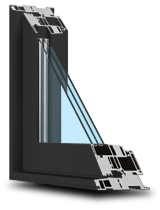European Windows vs North American: A Comprehensive Comparison Guide

When it comes to windows, there are distinct differences between European and North American styles that go beyond just aesthetics. From construction materials and energy efficiency to security features and customization options, the choices you make will have a significant impact on your home's overall comfort, safety, and energy costs. In this comprehensive guide, we'll explore the key distinctions between European windows and their North American counterparts, helping you make an informed decision for your next window installation or replacement project.
The Fundamental Differences
1. Construction Materials and Design
European Windows

European windows, often referred to as " tilt and turn windows " or "turn windows," are typically constructed using high-quality materials such as UPVC (Unplasticized Poly Vinyl Chloride), aluminum, or a combination of both. These windows are designed with a unique hinge system that allows them to tilt inward for ventilation or turn inward for easy cleaning from inside the home.
One of the standout features of European windows is their sleek, modern design. They often feature slim frames and larger glass panes, maximizing natural light and providing a seamless transition between indoor and outdoor living spaces.
North American Windows

In contrast, North American windows are predominantly made of wood, vinyl, or a combination of both. The most common types include:
- Double-hung windows : These windows have two operable sashes that slide vertically, allowing for both top and bottom ventilation.
- Casement windows : Hinged on one side, casement windows swing outward like a door, providing excellent ventilation and easy cleaning access.
- Sliding windows : As the name suggests, these windows have horizontally sliding sashes, making them a popular choice for areas with limited wall space.
While North American windows offer a wide range of styles and designs, they generally have thicker frames and smaller glass panes compared to their European counterparts.
2. Energy Efficiency
European Windows
One of the key advantages of European windows is their superior energy efficiency. Many European window manufacturers prioritize energy conservation, incorporating advanced technologies such as triple glazing , low-emissivity coatings , and gas fills between the glass panes. These features help reduce heat transfer, minimizing energy loss and lowering heating and cooling costs.
Read more about Triple-pane windows.
European windows also often meet or exceed stringent energy efficiency standards, such as the Passive House certification, making them an excellent choice for homeowners seeking to reduce their carbon footprint and utility bills.
North American Windows
While North American window manufacturers have made strides in improving energy efficiency, many still lag behind their European counterparts. Double-pane windows are the industry standard, with triple-pane options being less common and often more expensive.
However, it's important to note that some North American window companies offer high-performance, energy-efficient products that can rival or even surpass the efficiency of certain European models. These windows typically incorporate advanced glazing technologies, weather-stripping, and insulation to improve thermal performance.
3. Security Features
European Windows
European windows are renowned for their robust security features. Many models incorporate multi-point locking systems, which secure the window at multiple points along the frame, making them more resistant to forced entry. Additionally, the tilt and turn mechanism itself acts as a deterrent, as the window cannot be fully opened from the outside.
Some European window manufacturers also offer reinforced glass or laminated panes, further enhancing security and providing protection against potential break-ins.
North American Windows
While North American window manufacturers prioritize security, their security features may not be as advanced as those found in European windows. Standard locks and latches are common, but multi-point locking systems are less prevalent.
However, certain North American window brands do offer enhanced security options, such as reinforced glass, laminated panes, and upgraded locking mechanisms. These features can provide additional protection but may come at a higher cost.
4. Customization Options
European Windows
European window manufacturers often offer a wide range of customization options, allowing homeowners to tailor their windows to their specific needs and preferences. These options may include:
- Varied frame colors and finishes
- Decorative glass patterns or obscure glass for privacy
- Integrated blinds or shades
- Hardware and handle finishes
This level of customization enables homeowners to achieve a cohesive, personalized look throughout their home while addressing functional requirements.
North American Windows
While North American window manufacturers offer various styles and designs, the customization options may not be as extensive as those found in European window lines. Standard color choices and hardware finishes are typically available, but more specialized customizations may be limited or require custom orders, potentially increasing costs.
Comparison Tables
To help you better understand the differences between European and North American windows, we've compiled two comparison tables: one focusing on general features and the other on energy efficiency.
General Features Comparison
| Materials | UPVC, aluminum, or combination | Wood, vinyl, or combination |
| Design | Sleek, modern, slim frames | Traditional, thicker frames |
| Operation | Tilt and turn mechanism | Double-hung, casement, sliding |
| Security | Multi-point locking, reinforced glass | Standard locks and latches |
| Customization | Extensive options | Limited options |
| Installation | Typically requires professional installation | Can be DIY or professionally installed |
Energy Efficiency Comparison
| Feature | European Windows | North American Windows |
|---|---|---|
| Glazing | Triple-pane standard | Double-pane standard |
| Low-E Coatings | Common | Available, but less common |
| Gas Fills | Argon or krypton gas fills | Air or argon gas fills |
| Energy Ratings | Often meet Passive House standards | Varying ratings, some high-performance models |
| Frame Materials | UPVC or thermally broken aluminum | Wood, vinyl, or combination |
| Weatherstripping | Advanced weatherstripping systems | Standard weatherstripping |
It's important to note that these tables provide general comparisons, and there may be exceptions or variations among specific manufacturers and models.
Making the Right Choice
When deciding between European windows and North American windows, consider the following factors:
- Energy efficiency goals : If reducing energy costs and minimizing your environmental impact are top priorities, European windows with their advanced glazing technologies and high energy ratings may be the better choice.
- Security concerns : For enhanced security and peace of mind, European windows with their multi-point locking systems and reinforced glass options may be preferable.
- Aesthetic preferences : If you prefer a sleek, modern look with larger glass panes and slim frames, European windows may better align with your desired aesthetic. North American windows may be a better fit for more traditional or rustic styles.
- Customization needs : If you value personalization and the ability to tailor your windows to your specific preferences, European window manufacturers often provide more extensive customization options.
- Budget : While European windows generally come with a higher initial investment, their superior energy efficiency can lead to long-term cost savings on utility bills.
Ultimately, the decision between European windows and North American windows should be based on your unique needs, preferences, and priorities. Consulting with a reputable window professional can help you navigate the options and make an informed choice that best suits your home and lifestyle.
Conclusion
In the ongoing battle between European windows and North American windows, there is no clear winner – it ultimately comes down to your specific requirements and preferences. European windows excel in energy efficiency, security, and customization options, while North American windows often provide a more affordable alternative with a wide range of styles and designs.
By understanding the key differences outlined in this comprehensive guide, you can make an informed decision that aligns with your priorities, whether it's maximizing energy savings, enhancing security, achieving a specific aesthetic, or striking the perfect balance between functionality and budget.
Remember, investing in high-quality windows is a long-term investment in your home's comfort, safety, and value. Take the time to carefully evaluate your options, and don't hesitate to seek expert advice to ensure you make the best choice for your unique needs.
FAQs
1. What are the key features of European-style windows?
European-style windows, also known as tilt-and-turn windows, often feature slim frames, large glass panes, and a unique tilting/turning mechanism for easy ventilation and cleaning. They prioritize energy efficiency with triple pane or triple-glazed construction.
2. How do sliding doors differ from European windows?
Sliding doors are a common feature in both European and North American homes. They typically have large glass panels that slide horizontally, creating a seamless transition between indoor and outdoor living spaces. However, they lack the tilt and turn functionality of European windows.
3. Are exterior doors and entry doors the same?
While exterior doors and entry doors are often used interchangeably, entry doors specifically refer to the main door leading into a home or building. Exterior doors can include patio doors, sliding doors, and other door types that provide access to the outdoors.
4. What makes high-performance windows energy-efficient?
High-performance windows are designed with advanced glazing technologies like low-emissivity coatings, gas fills, and triple pane or triple-glazed construction. These features enhance thermal insulation, reducing heat transfer and minimizing energy loss, resulting in lower heating and cooling costs.
5. How do triple-pane windows improve energy efficiency?
Triple-pane windows, also known as triple-glazed windows, feature an additional glass pane and air or gas space between the panes, providing an extra layer of insulation. This minimizes heat transfer, improves thermal performance, and enhances overall energy efficiency compared to double-pane windows.
6. What are the benefits of European UPVC windows?
European UPVC windows are known for their durability, low maintenance, and energy efficiency. UPVC (Unplasticized Poly Vinyl Chloride) is a highly insulating material that helps minimize heat transfer, making these windows an excellent choice for energy-conscious homeowners.
7. How do North American windows differ in construction?
North American windows are typically constructed from wood, vinyl, or a combination of both. Common styles include double-hung, casement, and sliding windows. While energy-efficient options are available, they may not match the advanced glazing technologies found in many European window lines.
1000’s of Colours & Textured Finishes
Transform your home from ordinary to extraordinary with our new coloured and non-glare textured finishes. Available in a wide array of colours as well as custom matched colours for your very own personalized design.
Our Most Popular Replacement Window Colours:









